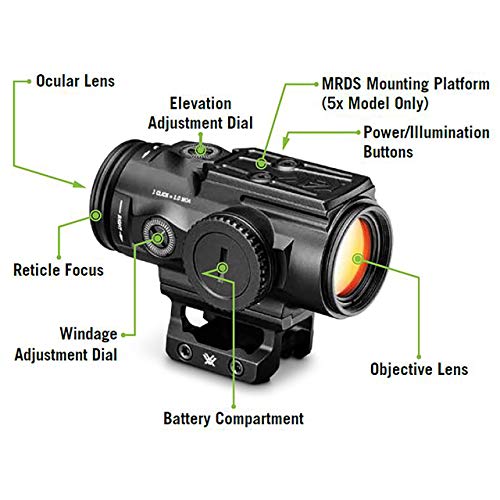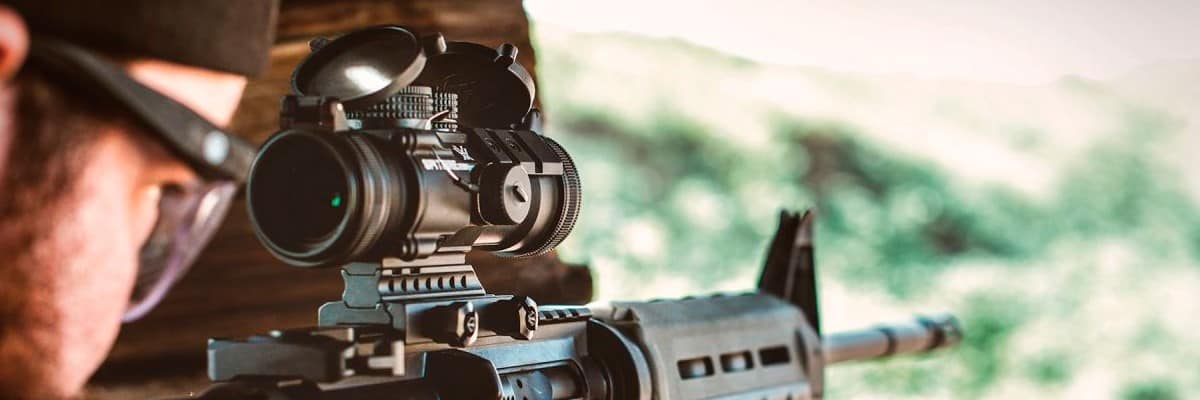Welcome back! Today I’m going to be taking a look at the Vortex Spitfire 3x Prism, a scope touted to be a blend of traditional sights and a reflex sight for shooters who are looking for rapid target acquisition as well as ranged precision. This scope’s got a lot to cover, so let’s get into it. Safety off, we’re going hot!
My First Impressions
When I first took the Vortex Spitfire 3x Prism out of the box, I was pleasantly surprised by the single-piece, sturdy housing. The compact design immediately gave me the impression of durability as well as functional practicality. As someone who values both precision at a distance and swift target acquisition in close-range scenarios, the Spitfire 3x seemed like a promising companion for my shooting ventures.
The scope is mounded by default, with lower 1/3 co-witness. This gives it a height of 40.4mm, but it offers the flexibility of a 30mm mounted height by removing the riser. The etched reticle, capable of red or green illumination with five brightness levels has a versatility that I’m excited to try out in the varying light levels of a full test day.
Overall, the initial impression was of a well-thought-out design aimed at providing a versatile, user-friendly sighting solution for a broad spectrum of shooting scenarios. Let’s see if it holds to that as we get into the details.
Optics Quality
While I already had moderately high expectations for a Vortex scope, I was still surprised at the impressive optical quality of the Vortex Spitfire 3x. It comes down to the fact that the prism-based design just sets the scope apart from others with traditional refractive optics. Prism scopes will typically have much clearer imaging, and with 3x magnification, the Spitfire 3x provides a clear, enlarged view of distant targets, aiding in accurate shot placement.
The multiple anti-reflective coatings on all air-to-glass surfaces are another feature that helps boost the Spitfire 3x’s image quality. These coatings help transmit more light, particularly in low-light conditions where every photon counts. This came in handy during early morning and late afternoon sessions at the range, where light conditions were far from ideal.
The Spitfire 3x does a commendable job of more or less eliminating chromatic aberration, which is often a concern with magnified optics. The images appeared sharp and clear with minimal color fringing, even at the edges. Additionally, the eye relief is very forgiving, which makes extended use comfortable in nearly any shooting conditions without creating eye strain.
If you want to check my other reviews on similar optics have a look at Primary Arms 3×32 prism scope or Vortex Strikefire 2 red dot scope.
Reticle Performance
The Vortex Spitfire 3x features an etched reticle directly set onto the prism, a design choice that offers a host of benefits. Unlike traditional wire reticles, an etched reticle doesn’t risk breaking or misaligning under heavy recoil or impact. This is critical for applications where your gun may see some impacts or strikes.
The ability to use the reticle with or without illumination is a huge plus. In bright daylight conditions, the etched reticle is visible without the need for illumination. However, when the lighting is suboptimal, the illumination is important. I personally enjoy the green and found it to be particularly useful in wooded or lush environments where it stood out well against the foliage.
With five levels of brightness, finding the right setting for the current lighting condition was straightforward. The controls for adjusting brightness are intuitive and easy to access even in a high-stress situation. Additionally, the straightforward, uncluttered reticle design aids in quick target acquisition at close range while still providing the necessary hold points for longer-range engagements.
No matter what the conditions were, the reticle stayed crisp and clear and was perfectly easy to see across a range of backgrounds. That alone is exemplary performance.
Turrets & Adjustments
The Vortex Spitfire 3x has both windage and elevation adjustment turrets, which don’t need any special tools or accessories to adjust on the fly. The turrets are easy to use, and provide tactile and audible clicks, giving clear feedback with each adjustment. The adjustment range has plenty of room for not only getting the zero you want but also making additional adjustments for conditions or long-distance shot requirements.
Once zeroed, the Spitfire 3x retains that zero even after some pretty extensive use and sustaining hard recoil from round after round of 300-blackout. This is a testament to the build quality and engineering of the turrets. They’re capped, so that you don’t accidentally adjust them, which is perfect for having to lug your rifle out to a hunt site.
Build Quality
The single-piece chassis is robust and built to withstand the rigors of real-world use. Its design lends to its durability while maintaining a compact and lightweight profile, making it a practical choice for various firearms. This scope is versatile and robust enough to be mounted on everything from a plinker to a hand cannon.
The O-ring sealed construction ensures that the Spitfire 3x is waterproof, and the optics remain clear even when exposed to rain or moisture. The fog-proof performance ensured through nitrogen purging, was notable during early morning outings where temperature fluctuations were prevalent. The external surfaces are treated with a protective coating that seems to resist scratches and abrasions well, maintaining the scope’s aesthetic and functional integrity even after extensive use in rugged environments.
The Spitfire 3x comes with a co-witness rail mount, providing a solid and secure attachment to the firearm. The ability to choose between a lower 1/3 co-witness height of 40.4mm and a lower 30mm mounted height by removing the mount riser adds a level of customization to fit personal preferences and firearm configurations.
Real-Life Testing: A Day In The Field
Taking the Vortex Spitfire 3x out into the field was an experience that let me get up close and personal with the scope’s capabilities. The day started early, with a trip to a local range known for its varying distances and terrain types, providing an ideal testing ground for the Spitfire 3x. Setting up the Spitfire 3x on my AR-15 was a breeze, thanks to the user-friendly mounting system.
The first series of tests involved close-range engagements at distances ranging from 25 to 100 yards. The 3x magnification provided a clear, enlarged view of the targets, aiding in rapid target acquisition and precise shot placement. Moving on to longer ranges, the Spitfire 3x continued to impress. The clarity of the image, even at the edges, facilitated accurate shot placements at distances extending to 300 yards. The reticle subtensions aided in holdover estimations, making the transition to longer-range shooting smooth.
As daylight faded, the adjustable illumination levels of the Spitfire 3x came to the fore. Adjusting the brightness to match the fading light ensured the reticle remained visible and sharp, facilitating accurate shots well into dusk. Whether it was the rapid engagement at close quarters, the precision required for longer ranges, or the durability to withstand real-world rough handling, the Spitfire 3x rose to the challenge.
Pros & Cons
Pros
- Etched Reticle: The etched reticle ensures visibility with or without illumination, providing a reliable sighting solution.
- Illumination Settings: The adjustable illumination with red/green options and five brightness levels offers versatility to match varying lighting conditions.
- Versatile Mounting Options: The co-witness rail mount with adjustable height offers flexibility to accommodate personal preferences and firearm configurations.
- 3x Magnification: The 3x magnification is a sweet spot for both close and mid-range engagements, providing a clear view for precise shot placements.
Cons
- Fixed Magnification: While the 3x magnification is versatile, the fixed magnification might limit its use in scenarios requiring higher magnification for extremely long-range engagements.
- Battery Life: While not a major issue, scopes with longer battery life might be a preferable option for extended field use without access to battery replacements.
Who Should Buy This Scope?
The Vortex Spitfire 3x is a highly versatile optic that caters to a wide array of shooters and applications. Here’s a breakdown of who might find the Spitfire 3x to be a perfect fit for their needs:
- Tactical Shooters: The robust build, clear optics, and illuminated reticle make the Spitfire 3x an excellent choice for tactical shooters.
- Competitive Shooters: The Spitfire 3x could serve competitive shooters well, especially in competitions that demand a blend of speed and precision.
- Recreational Shooters: For those who enjoy range days and plinking, the Spitfire 3x provides a reliable and user-friendly optic solution. The ease of mounting and adjusting, coupled with clear optics, enhances the shooting experience.
- Home Defense: The quick target acquisition, illuminated reticle, and robust build also make the Spitfire 3x a viable option for home defense, allowing homeowners to accurately and quickly address threats.
The Final Word
In my experience, finding a good 3x scope can be tricky, but the Vortex Spitfire 3x Prism Scope is absolutely a top-tier optic choice. Its blend of clarity, durability, and user-friendly features make it a valuable addition to just about any firearm setup. The Spitfire 3x delivers a performance that justifies its reputation and makes it a solid investment.
If you are interested in my other reviews have a look at Vortex Razor AMG UH-1 red dot optic and Burris FastFire 3 red dot optic.
Mike Fellon is an experienced firearms enthusiast and optics expert. He delivers unbiased and detailed rifle scope reviews. Born and raised in Dallas, Texas. He inherited his hunting passions after his father John – he was fascinated by his stories, hearing how much attention, focus, dedication and patience he invested in shooting every animal. When he was old enough, his father first allowed him to shoot some cans and bottles with his shotgun, and then took him hunting – it was love at first sight. Mike has never stopped shooting ever since.

